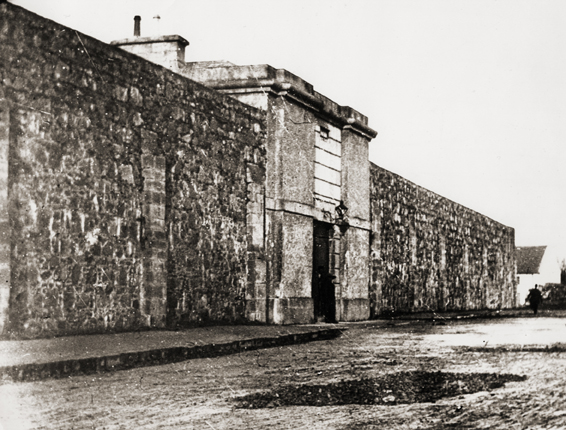Executions in Galway Gaol

This photograph of the main entrance to Galway Gaol (facing the Salmon Weir Bridge) was taken in 1903. It was an imposing and intimidating building. The execution chamber was just over the main gate, and many prisoners perished there.Among those were three men, Thomas Higgins (Long), Patrick Higgins and Michael Flynn who were found guilty of killing bailiff John Huddy and his grandson at Cloughbrack on Lord Ardilaun’s estate. They dumped the bodies into Lough Mask, and as a result were tried and convicted and finally hanged in January 1883 by executioner William Marwood.
Two years later,a man called Michael Downey managed to confuse successive juries before being convicted of murder at his third trial. He shot and killed John Moylan in Clonboo. Police believed he was having an affair with Moylan’s wife, and that she paid him to shoot her husband. Eventually, Downey admitted the crime but said Mrs. Moylan had nothing to do with it. He was hanged by executioner James Berry on January 16th, 1885.
In July 29th, 1884, Thomas Parry stayed in the Imperial Hotel. The following morning he went next door to the Royal Hotel to see Alice Byrnes to whom he had been engaged, but who was now returning his love letters. As she went to shake his hand, he produced a revolver and shot her. The police came down from Prospect Hill and arrested him, and he was tried, found guilty and eventually was executed by James Berry on January 20th, 1885.
Thomas Keeley was a painter who, in 1902, shared a house with an elderly lady, Mary Clasby in North Gate St. Athenry. While drinking one night, they quarrelled, he hit her on the head with his painter’s hammer and killed her. A few days later a relation of Mary’s arrived and asked for her. Keeley told her she was sick, but she persisted and found the body. A jury found Keeley guilty and he was condemned to death.
At the time there was no permanent scaffold in the gaol, so a 2-storey building was erected adjoining the women’s quarters in the north of the prison. The brickwork was run up against the wall of the old prison building. On the top storey was a scaffold which consisted simply of an overhead beam with a rope dangling from it, while portion of the floor opened out and fell down on large hinges, precipitating the body into space in the apartment below.
The condemned cell opened right on to the upper apartment, “an excellent arrangement as its proximity to the ‘drop’ did away with the melancholy procession which was always such a trying feature at executions”. Fr. Creaven & Fr. Considine celebrated mass in Keeley’s cell sometime before 8am on April 29th, 1902. All being ready, Keeley was pinioned, the door of the cell was thrown open and he was led to the ‘drop’. He had but three paces to cross the floor and was immediately placed under the beam, the white cap drawn over his head, and in less than a minute, the executioner Billington stepped back, drew the bolt and the unfortunate man was launched into eternity. He was the last man to be executed in Galway Gaol.
In 1923, six prisoners were taken from Galway Gaol and brought to Tuam, where they were executed the following day, April 12th. They were James O’Malley, Oughterard; Frank Cunnane, Kilcoona; Michael Monaghan, Clooneen, Headford; John Newell, Headford; John McGuire, Cross, Cong and Martin Moylan, Annaghdown. They became known as “The Tuam Martyrs”.
Ronan Killen is researching a paper on all of these executions and would greatly appreciate any help in the form of information, news clippings, photographs or whatever that readers might be able to loan him. He can be reached at 087 419 5151 087 419 5151, or by email at This email address is being protected from spambots. You need JavaScript enabled to view it.
087 419 5151, or by email at This email address is being protected from spambots. You need JavaScript enabled to view it.
TK
Please forward any queries/comments to This email address is being protected from spambots. You need JavaScript enabled to view it.
View the Old Galway Archive.